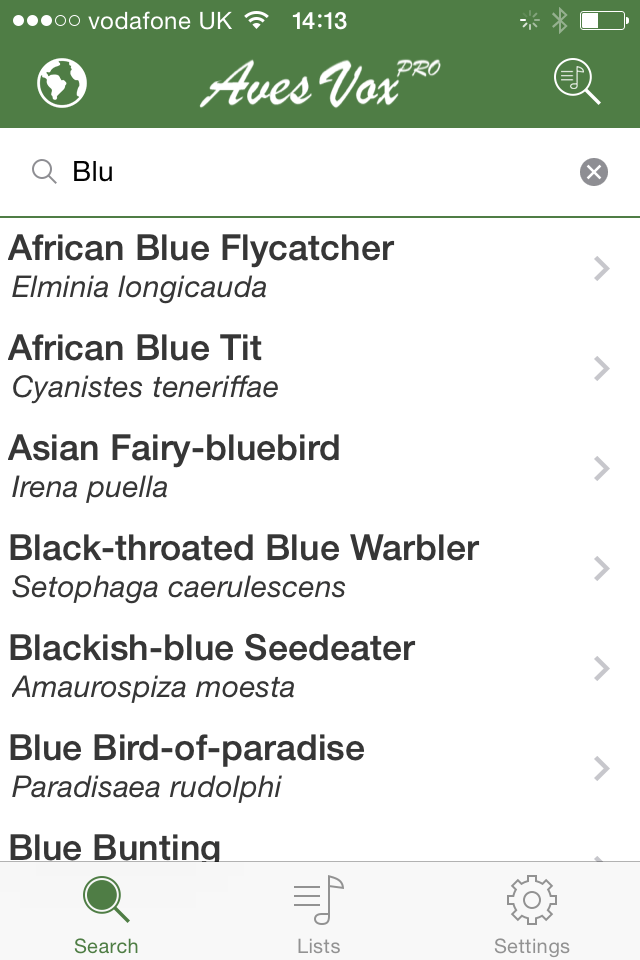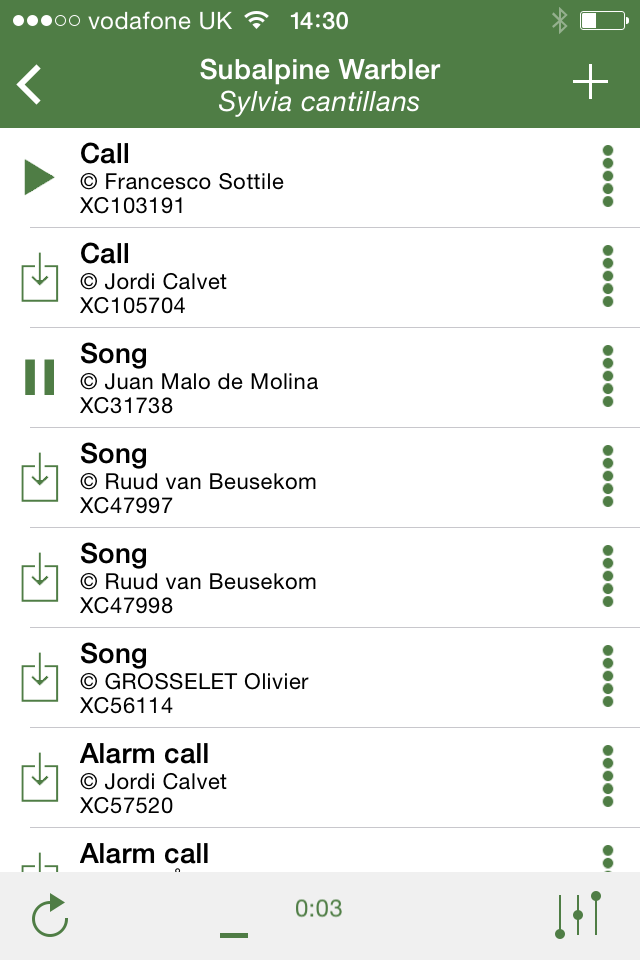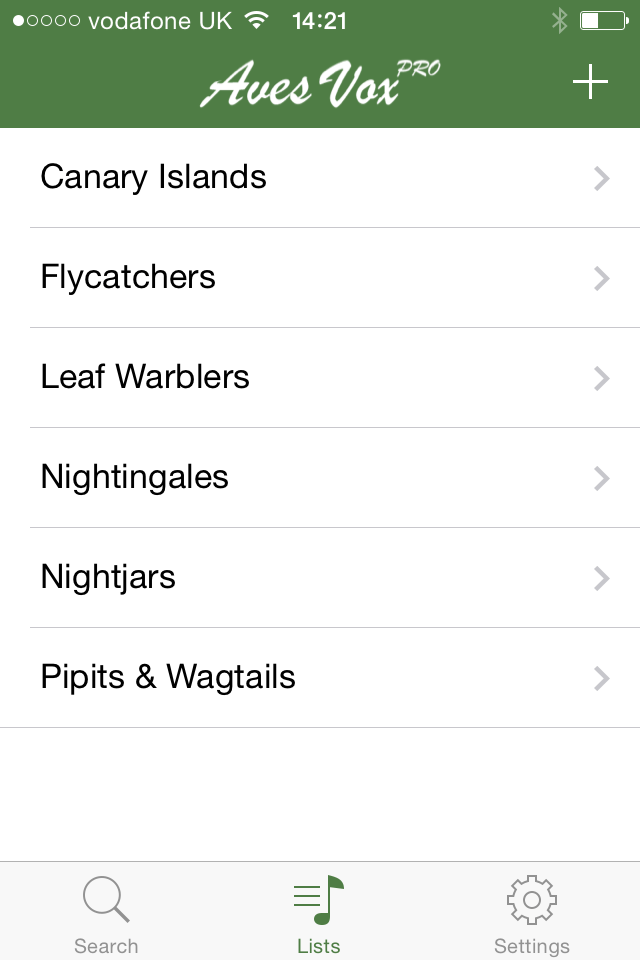App Review: Aves Vox Pro for iOS
One of the main functions for which the smartphone was conceived is audio – the iPhone evolved from Apple’s line of iPod music players, after all. So it is no surprise that one of the main uses of smartphones for birders should be for storage and playback of bird songs and calls. One way to achieve this is simply to convert your existing bird song CDs into a series of MP3 files and store them with your music, but is there a better way?
The main drawback historically of these CDs was the limited variety of songs or calls which were available. In contrast, the Xeno-canto website now provides access to a mind-boggling variety of bird vocalisations from around the world via the internet. The Aves Vox apps offer easy access to a large part of this Xeno-canto library via a simple smartphone app for Apple iOS devices. Aves Vox Pro is the paid-for version of the app.
Features & Functionality
Aves Vox claims to include at least one vocalisation for over 80% of all bird species worldwide, including more than 30,000 recordings. While it is possible to access the Xeno-canto website itself on a smartphone, via its browser, the app offers several advantages. The main one is that it can work offline. Any recordings which have already been played in the app are downloaded to the device, allowing them to be listened to again when there is no internet connection available. Given so many parts of the world (and even the UK!) have poor or no mobile coverage, this is a major positive. It also allows the creation of a personalised library of downloaded bird sounds tailored to where you are going or whichever species you are particularly interested in. The app is also generally quicker to search than going via the Xeno-canto website.
The main disadvantage versus Xeno-canto is that the app contains only a small proportion of the total number of recordings available via the website. At the time of writing, Xeno-canto offers nearly 190,000, over six times the number in Aves Vox. For the most part, the app offers a good selection of vocalisations for each species, but it is not hard to find exceptions. Xeno-canto itself only includes four recordings of Pechora Pipit, for example, but only one of these is available via Aves Vox and that is a song clip. Neither of the two flight call recordings on the website is currently available via the app. However, despite this the app is still an amazingly extensive resource.
The basic Aves Vox is available as a free download, but the paid-for Pro version offers some significant advantages over the base app. These include the ability to create and search through customised species lists, to delete recordings from the device, and to filter recordings by vocalisation types. This review therefore looks specifically at Aves Vox Pro, although the key differences from the free app are highlighted.
The app is fairly easy to use, once you are familiar with it. Starting brings up the search page. Type in a species in the search box, either using its common or scientific name, and the app starts to narrow down the possibilities after the first three letters are typed and displays them in the scrollable list below. However, it should be noted that the app can sometimes be frustratingly slow to respond here. Once the desired name is found, a single tap brings up the available recordings for that species and a tap on one of those downloads that recording. The icon to the left of each recording shows whether it has already been downloaded and is available for playback.
The vocalisations are categorised according to song, call, flight call, alarm call and other calls. In Aves Vox Pro it is possible to filter the recordings to show only one vocalisation, which is useful if you are looking for a particular type. However, they are not always correctly categorised – one recording under Blyth’s Pipit is given as flight call but is actually song given in flight, for example. Similarly complex recordings with both songs and calls are not identified, so Moltoni’s Warbler appears to include only three songs whereas the distinctive calls are actually present on all of them. The description of the recordings also lacks the other detail provided on Xeno-canto and in particular it has no detail on recording location. This is a key omission where different forms have different vocalisations – for example Subalpine Warbler is not split into Eastern and Western and there is no way of telling to which form any recording relates.
The playback itself is clear, but the controls are frustratingly limited to ‘play’ or ‘pause’. When a recording has been ‘paused’, it will only start again from where it was stopped and there is no way to go back to the start without leaving the species page. The status bar at the bottom shows the elapsed time for that recording but no detail on how far through it has played or the total recording length. In the Pro version it is possible to repeat playback, but this has to be preset in Settings rather than applied to individual recordings as they are played, which makes it less useful.
Creating lists in Aves Vox Pro is easy and this facility is particularly useful in allowing the user to set up customised lists of species and recordings which are then more easily accessed in the future. On any species page, tapping on the ‘+’ icon at the top offers the possibility to add that species to an existing named list or create new one. Tapping on the lists icon on the homepage and then on a list name takes you directly to your chosen recordings, without have to back through the search function. All the available recordings are still shown, rather than just the ones which have already been downloaded, which might have been more useful, at least as an option. On the search page it is also possible to look for a species only in a single specific list, which is faster than looking through all the species in the app, but perhaps a facility to search through all personal lists at once might be a handy addition.
The Pro version offers the possibility to delete downloaded recordings, which should be useful in managing the memory requirement of the app. However, there is no way of seeing which recordings have already been downloaded without going to the individual species pages, which might be a problem if you can’t remember which you already have. A way of seeing all recordings stored on the device would be helpful here. Without that, managing a large library of bird sounds over the long term might be difficult, without reinstalling the app and starting all over again. It is possible to delete recordings completely from the list of those available, but this cannot be undone so is possibly best avoided.
There are unfortunately other issues with the app which suggest it is not yet the finished article. It appears to be somewhat buggy and has a corresponding tendency to freeze at times. It could also be easier to navigate and rather annoyingly there is no ‘home’ button. When you have finished listening to recordings, tapping the ‘back’ icon goes back through the pages previously viewed. Similarly, there is no way to go directly to the lists page or to settings, without going back to the home page. The developer is still adding features, so hopefully some of these issues can be addressed in future updates.
Aves Vox Pro is only available for Apple devices and there is no information on whether an Android version is to be released. It is compatible with iPhone, iPad and iPod Touch running iOS 7.0 or above. The file size is quoted as a refreshingly small 6.2MB, although this increases rapidly once recordings are downloaded. It is available from the app store, at the particularly attractive price of only £2.99.
Conclusion
The enormous range of bird vocalisations on Xeno-canto is a fantastic resource and access to even a fraction of this is well worth having on a mobile device out in the field. While some bird songs and calls are available as part of electronic field guides like the Collins Bird Guide app, Aves Vox offers a much wider range of recordings and is not limited in geographic scope to just Britain and Europe, for example. More focused bird song apps are similarly constrained in scope and typically much more expensive. Aves Vox therefore offers a more competitively priced alternative which would be an attractive supplement to any field guide. It would prove particularly useful in putting together a collection of bird sounds for a foreign trip or a personal collection of key confusion species, for example.
Given the low price, it is well worth paying for Aves Vox Pro rather than using the free version, to gain access to the useful additional features. Despite the issues, which hopefully can be addressed in future releases, Aves Vox Pro is still a very useful app and well worth having on any birder’s smartphone.
Marcus Nash
01 October 2014







